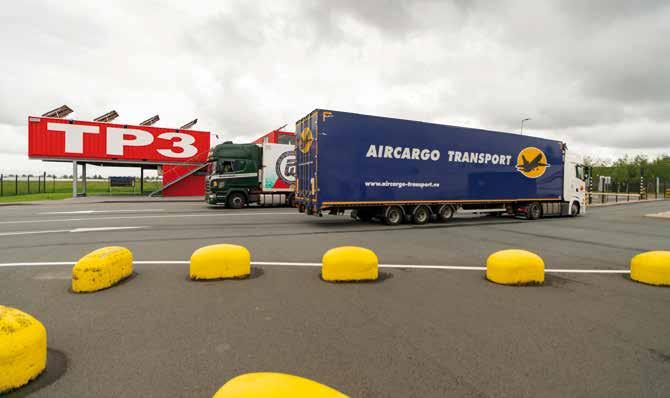
8 minute read
Shaping the future of aircargo
by Cargomedia
In the post-Covid-19 how would air cargo change?
Out of the blue, the covid pandemic shattered global commerce, social behaviour and human interchange. Transport of people and goods almost collapsed, and governments rushed to acquire vital medical supplies. The devastation has revealed some serious weaknesses in our social behaviour and our ability to re-establish a “new normal”.
Advertisement
Editor Mike Sales, with input from SASI
The air logistics industry needs to define its future now. Increasingly, leaders are recognising that air cargo should be established as a core business rather than an afterthought that reverts to where it was before the pandemic. For far too long, aviation operators, especially carriers and airports, have ignored the important role played by cargo, placing most of their resources in passenger traffic development and on airport retail. The shock and horror of the overnight loss of activity, which has pushed airlines and airports into panic mode, has highlighted the world’s dependence on air cargo’s ability to keep delivering.
If cargo is going to be a core business in the future, a new business model, such as virtual integration, will be required to meet the challenges and opportunities that will emerge. To achieve such changes successfully, a collaborative approach is needed, requiring an additional set of skills. Some forwardthinking carriers started this process before the pandemic, but the urgent need to mitigate the destructive effect of Covid-19 on the aviation industry has accelerated. The race is on for companies to position themselves as cargo leaders. Strong indications are that passenger travel will be slow to recover, cargo traffic may well be the primary source of revenue for airlines, handlers, forwarders and airports, for the foreseeable future.
Most current economic forecasts predict a slow recovery over the next three to four years. During this period, the demand for goods, especially time-sensitive, will continue to expand, often at the expense of traditional retailers. How then do operators exploit the opportunities which e-Commerce presents? As has been demonstrated, large operators such as Amazon have been investing in their own transport fleets but will always call on the cargo airline operators to supply necessary capacity. How will personnel requirements need to change from the handlers, airport operators, road feeder networks? Nearshoring of supply chains and geopolitical impact on demand and capacity and when employees are geographically dispersed and face-to-face personal interaction is restricted, will be some of the factors in play. This will require a set of skills not traditionally available in logistics-focused education and training programmes. This industry is based on service and to improve business outcomes, considerable investment in developing employees will be vital. Learning and development is usually one of the first casualties of cost reductions, but the air logistics business needs to focus even more on training and developing of personnel to support new objectives.
A new business model, in a new normal, requires a change of mindsets and practices, but don’t throw the baby out with the bath water! The technical skills that can meet the immediate and future needs of a company are still needed. Questions to ask are what are the skillsets that are relevant during this time and what will take the industry into the future to operate effectively and profitably in the new environment? Do current leaders have the capability to be flexible and resilient enough to adapt, engage the employees and lead in different situations using different tools?
Digital Transformation
Air cargo customers expect the same easy access to booking and tracking shipments as in arranging flights and hotels. To achieve this type of service for air cargo, digitization is the entry point for evolving systems. This results in a streamlined and seamless process with fewer points of disruption in the flow of information.
Michael Sales
The Air Cargo Industry – and indeed the supply chain as a whole, has been based on complicated paper documents and systems for far too long. Much of the necessary paper trail stems from a history of regulations that require forms and stamps, often in triplicate. New standards are slowly being approved and adopted that will reduce hard-copy requirements and allow industry players to leverage digital documentation. This will eventually generate significant time-savings and increase accuracy. The International Air Transport Association (IATA) has said that an air cargo booking is manually retyped as many as 97 times as it passes from one system to the next. That is 97 opportunities for an error. The manual retyping is a result of many systems that have sprung up in an attempt to automate, but which unfortunately do not integrate with each other.
In addition, such digitization will allow greater visibility into operations and produce reliable data from which business decisions can be driven. Digitization will not only help air cargo carriers meet evolving customer needs for greater transparency into the transportation of their cargo, it will also help customers streamline their own operations.
The frequently ignored but vital part of the air cargo chain - handling and road feeder service, is a good example of how a technology application can vastly improve and streamline the process. The Trucking CDM platform from CargoHub, eliminates the guesswork of trucks waiting, sometimes for hours, not knowing where their shipment is or where to deliver to the handler. The CDM platform shows all truck movements to the handling agents and airlines with expected arrival times which are continually updated. Predictability and transparency of truck movements are necessary for all parties involved at the various airports, in order to facilitate road transport of air cargo to its loading and unloading destinations. The more parties sharing their data on the CDM platform, the more benefits can be reached through the entire logistics chain.
Living Laboratory
According to Giovanni Douven, project manager, “The Trucking CDM platform is the starting point for future research into a comprehensive Cross Chain Control Center (4C) project for air cargo. The complexity of connections between parties involved provides extensive research and education possibilities for Inholland. The 4C project forms a ‘living laboratory’ or eco system, as it were, to further examine and educate. After all, the connection between parties goes beyond the mere pick-up and delivery of shipments. The air cargo industry is, despite many improvements, a fairly traditional sector involving many different parties. Inholland believes that everyone in the air cargo industry should be connected in the cloud, where each player should share relevant data with other parties involved.”
Air Cargo Is Society’s Partner
Air cargo has been the lifeline to the planet and its citizens. During the pandemic, TV and all news media have shown vital medical equipment and vaccines being unloaded from both freighter and passenger aircraft. Perhaps now, there will be a greater awareness of the role of air cargo as the world staggers towards the “new normal”.
What makes the industry work? What lessons were learnt and how will it continue to support global society and industry as they continue to evolve? Technology will play a vital part, but equally people must recognize the need for these services and not cast the aviation industry as the villain.
Michael Sales is a freelance journalist and press consultant, specializing in the global logistics industry. He is Managing director of IMC Creations, a logistics press consultancy established in 1998.

LOGISTICS WORLDWIDE


Your Manager in Worldwide Logistics
Our airfreight office is located at Amsterdam Schiphol Airport (AMS), The Netherlands which is one of the major European Gateways. GFM is your (IATA) partner for all your Airfreight, Time Critical, Dangerous Goods (Cat. 6 certified) and Oversized Cargo.
Clear and fast communication is our key in Airfreight traffic!
Contact
Sales@GFM.world +31 20 2616 422
Cargo Media Speenkruid 20 2408 LL Alphen aan den Rijn
Magazine Management Esther Kort-Boreas
Advertising Email: redactie@cargomagazine.nl
Design and layout Cargo Media
Photography De Beeldredacteur, Michel ter Wolbeek
Photo cover Sven van der Vlugt
Circulation 4.000 copies
Subscription and address changes Subscription requests or address changes can be sent by email to: redactie@cargomagazine.nl
© Cargo Magazine No part of this publication may be reproduced and/or published by means of printing, photocopying, film or in any other way whatsoever without the prior permission of the publisher. The publisher shall not be liable for any inaccuracies in this publication and is not responsible for acts by third parties that potentially result from reading this publication.
www.cargomagazine.nl
SCAN QR CODE FOR ENGLISH VERSION
MEDIA PACK CARGO MAGAZINE
ABOUT CARGO MAGAZINE
Cargo Magazine is distributed completely free of charge amongst professionals within the cargo industry. The 4000 printed magazines in the Dutch language are distributed in the Netherlands and Belgium. The online magazine is in both Dutch and English language and distributed within our international network with over 35000+ business relations.
GEOGRAPHY AND AUDIENCE
The printed version mainly Schiphol, Eindhoven, Maastricht, Rotterdam and Amsterdam and Brussels. The Online version is worldwide distributed amongst middle and higher Management cargo industry professionals (Airlines, Handling agents, Forwarding agents, Road Truckers, Shippers import and export as well as Government and logistic service providers).
SUPPORT AND FREE SUBSCRIPTION
Your support in textwriting, advertising, editorial or sharing our magazine within your network is highly appreciated.
Join our next edition or subscribe? Contact: redactie@cargomagazine.nl
PRICELIST 2021
Advertorial
Interview 3 page + cover photo 3 pages 2 pages 1 page
Advertisement
1/4 Page full colour 1/2 Page full colour 1 Page full colour Innerpages 2-3 1 Page full colour | Backside 2 Page full colour 2 page spread Insert per title
Dimensions and Format
21% VAT not included
Price in Euro
3.950,2.250,1.950,1.250,-
Price in Euro
300,–500,–900,–1.450,1.450,1.500,1.950,950,-










